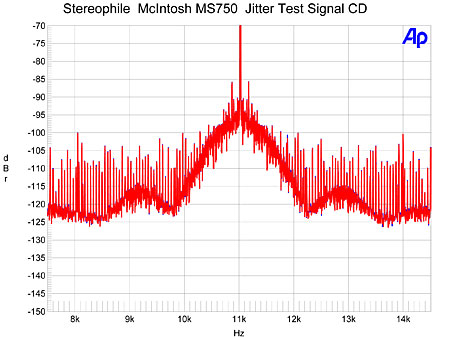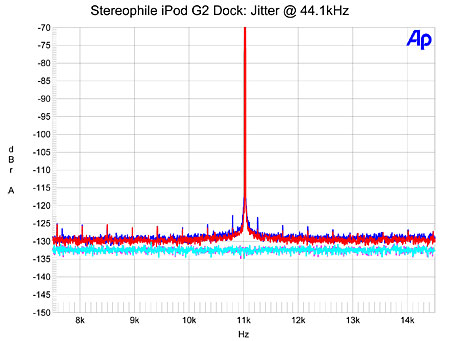| Columns Retired Columns & Blogs |
A Case of the Jitters Less than "CD quality"
Test Results 1: Less than "CD quality"
McIntosh MS750 media server
$6000, reviewed by Wes Phillips in January 2008.
Whether the MS750 was playing back a FLAC-encoded, "CD-quality" file or a CD, the player offered a very high measured level of jitter: nearly 14ns, or two orders of magnitude higher than the best players I have measured. Significant spectral spreading can be seen in the spectrum of the McIntosh's output (fig.4), which suggests the presence of high levels of random low-frequency noise affecting the clock-generator circuit, as well as pairs of sidebands at high levels and low frequencies, and at higher frequencies but lower levels. The averaged level of the noise in this graph is around 12dB higher than the 16-bit noise floor, suggesting closer to 14-bit performance than the necessary 16-bit. As suggested in the review, the McIntosh needs to be used with a standalone D/A processor to give the best sound.

Fig.4 McIntosh MS750, high-resolution jitter spectrum of analog output signal, 11.025kHz at –6dBFS, sampled at 44.1kHz with LSB toggled at 229Hz, CD playback (left channel blue, right red).
Sony PlayStation 1
around $25 secondhand, reviewed by Art Dudley in July 2008.
Art Dudley was very impressed with both the sound and the value for money of the first-generation PS1 when bought secondhand. However, the game station offered only moderate rejection of word-clock jitter, at 737ps peak–peak, with most of the jitter coming from a pair of sidebands at the data-related frequencies of 11.025kHz, ±229Hz, and the AC supply–related frequencies of ±60Hz (fig.5). The noise level is around 7dB higher than the 16-bit noise floor, implying that the resolution lies just below the 15-bit level.

Fig.5 Sony PlayStation 1, high-resolution jitter spectrum of analog output signal, 11.025kHz at –6dBFS, sampled at 44.1kHz with LSB toggled at 229Hz (left channel blue, right red); cyan and magenta traces show noise floor of perfect CD data.
Pioneer DV-578A universal player
$150 (not reviewed).
I bought the Pioneer in 2004 from online retailer The Audio Advisor in order to have a handy reference available for when I tested universal players capable of playing back SACD and DVD-A discs. (Many audiophile players are based on the same Pioneer parts kit.) To my surprise, the noise floor in fig.6 is around 3dB higher than the 16-bit limit, meaning that this universal player will be incapable of retrieving SACD and DVD-A audio with full resolution. Large numbers of sidebands are visible, mainly at data-related frequencies, and the jitter level was a moderately high 457ps peak–peak.

Fig.6 Pioneer DV-578A, high-resolution jitter spectrum of analog output signal, 11.025kHz at –6dBFS, sampled at 44.1kHz with LSB toggled at 229Hz (left channel blue, right red).
Apple iPod Touch G2
$300 (not reviewed).
The volume was set to maximum for this player and all sound processing was turned off. The second-generation Touch, which plays back files from 16GB of RAM rather than the tiny hard drives of earlier iPods, has very few sidebands visible in its spectrum, though significant spectral spreading can be seen around the central spike that represents the 11.025kHz tone (fig.7). However, while the noise floor is only a few dB higher than the 16-bit floor, a large number of spectral spikes can be seen, these presumably stemming from clock circuits needed by the ARM microprocessor. The Touch is a remarkably versatile portable device, but the older iPods were better overall for pure music playback, as seen in the next graph.

Fig.7 Apple iPod Touch, high-resolution jitter spectrum of analog output signal, 11.025kHz at –6dBFS, sampled at 44.1kHz with LSB toggled at 229Hz (left channel blue, right red).
Apple iPod G3
$400, reviewed by Wes Phillips in October 2003.
Again The volume was set to maximum for this player and all sound processing was turned off. While the third-generation iPod's noise floor is around 6dB higher than is theoretically possible from a 16-bit system, presumably a result of the low rail voltages available for the DAC and output stage, only a few sidebands can be seen above the noise in fig.8. These are spaced at multiples of 229Hz on either side of the central peak and are therefore data-related. The overall result is superbly low, at 225ps peak–peak, and this long-obsolete iPod is actually better in all respects than the 2008-vintage iPod Touch I tested.

Fig.8 Apple iPod G3, high-resolution jitter spectrum of analog output signal, 11.025kHz at –6dBFS, sampled at 44.1kHz with LSB toggled at 229Hz (left channel blue, right red); cyan and magenta traces show noise floor of perfect CD data.
- Log in or register to post comments




































